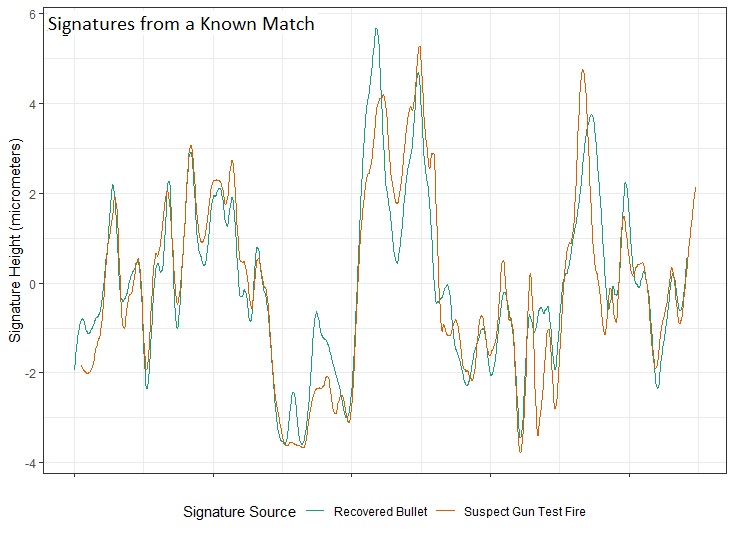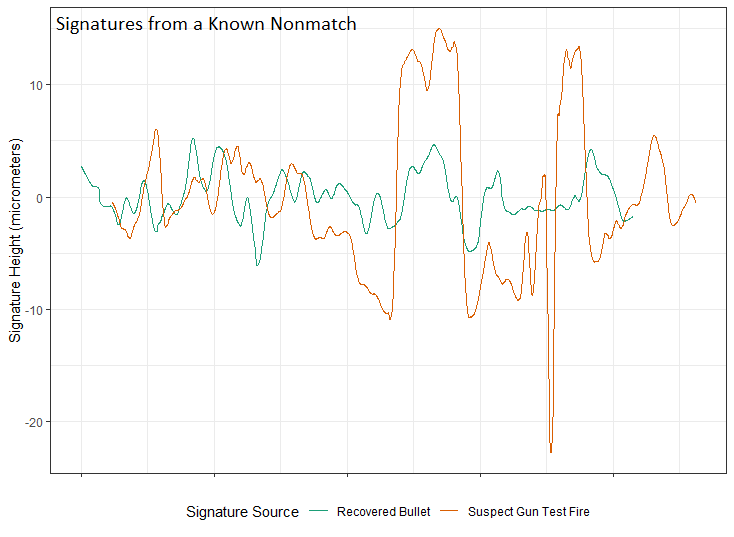1 You will now read a transcript of testimony given by Terry Smith at trial.
Q: Please state your name.
A: Terry Smith.
Q: Who do you work for?
A: The local police department.
Q: What do you do for the police department?
A: I am a firearms examiner.
Q: How long have you been doing that?
A: 7 years
Q: What is a firearms examiner?
A: A firearms examiner is someone who looks at cartridge cases and bullets to determine whether they were fired from a particular firearm.
Q: What training is required to become a firearms examiner with the local police department?
A: I received my bachelor's degree in forensic science and in 2015 I transferred to the crime lab from the crime scene unit. I underwent a two-year training program, which was supervised by experienced firearms examiners; I've toured manufacturing facilities and saw how firearms and ammunition were produced; and I've attended several national and regional meetings of firearms examiners.
Q: And during the course of your career, were you tested in proficiency to make sure you were still conducting appropriate examinations?
A: Yes. I have undergone annual proficiency examinations.
Q: Is the local police department lab accredited?
A: Yes, it is accredited by ASCLID/LAB.
Q: Please state your name.
A: Terry Smith.
Q: Who do you work for?
A: The local police department.
Q: What do you do for the police department?
A: I am a firearms examiner.
Q: How long have you been doing that?
A: 7 years
Q: What is a firearms examiner?
A: A firearms examiner is someone who looks at cartridge cases and bullets to determine whether they were fired from a particular firearm.
Q: What training is required to become a firearms examiner with the local police department?
A: I received my bachelor's degree in forensic science and in 2015 I transferred to the crime lab from the crime scene unit. I underwent a two-year training program, which was supervised by experienced firearms examiners; I've toured manufacturing facilities and saw how firearms and ammunition were produced; and I've attended several national and regional meetings of firearms examiners.
Q: And during the course of your career, were you tested in proficiency to make sure you were still conducting appropriate examinations?
A: Yes. I have undergone annual proficiency examinations.
Q: Is the local police department lab accredited?
A: Yes, it is accredited by ASCLID/LAB.
2 Q: And in addition to what you just told us, do you have other qualifications?
A: Yes, I do.
Q: Can you tell us what those are?
A: Yes. I received training in the use of a bullet matching algorithm. This is an algorithm that evaluates the characteristics of two fired bullets, in order to produce a score for the similarity of the bullets, where more similar bullets are more likely to have been fired from the same gun. I attended a workshop on the algorithm on 1/11/2020, held by CSAFE - Center for Statistics and Applications in Forensic Evidence. The training taught me to use the algorithm alongside my personal judgement. I found that my conclusion was reflected in the similarity score produced by the algorithm in all 21 cases.
Q: Where does the bullet matching algorithm come from?
A: It was created by Dr. Adrian Jones.
Q: How long have the state police been using the bullet matching algorithm?
A: They have been using it since January of 2020.
Q: Have you testified in court previously using the bullet matching algorithm?
A: Yes, I have, approximately 10 times.
Q: As a firearms examiner, have you testified about your conclusions, given the results of your testing?
A: Yes, I have.
A: Yes, I do.
Q: Can you tell us what those are?
A: Yes. I received training in the use of a bullet matching algorithm. This is an algorithm that evaluates the characteristics of two fired bullets, in order to produce a score for the similarity of the bullets, where more similar bullets are more likely to have been fired from the same gun. I attended a workshop on the algorithm on 1/11/2020, held by CSAFE - Center for Statistics and Applications in Forensic Evidence. The training taught me to use the algorithm alongside my personal judgement. I found that my conclusion was reflected in the similarity score produced by the algorithm in all 21 cases.
Q: Where does the bullet matching algorithm come from?
A: It was created by Dr. Adrian Jones.
Q: How long have the state police been using the bullet matching algorithm?
A: They have been using it since January of 2020.
Q: Have you testified in court previously using the bullet matching algorithm?
A: Yes, I have, approximately 10 times.
Q: As a firearms examiner, have you testified about your conclusions, given the results of your testing?
A: Yes, I have.
3 Prosecution: Your Honor, at this time I would ask that Terry Smith be qualified as an expert in the field of
firearms identification subject to cross examination.
Court: Any cross on their credentials?
Defense: No, Your Honor.
Court: This witness is an expert in the area of firearms identification. They can testify to their opinions as well as facts. Go ahead.
Q: What work did you do on this case?
A: I was asked to compare a bullet from the crime scene to a test fire from the gun recovered from the traffic stop.
Q: Did you examine how many lands and grooves the bullet had?
A: Yes.
Q: Can you explain for the jury what that means?
A: Yes. In the interior of a barrel there are raised portions called lands and depressed areas called grooves. When a bullet passes down the barrel, a bullet will spin and that gives it stability and accuracy over a distance. Those raised areas are designed by the manufacturer. They're cut into the barrel. And each particular file has a different combination of lands and grooves. But essentially what those lands do is grip a bullet and spin it, and as that bullet passes down the barrel, it scratches the random imperfections of that barrel into the bullet.
Q: Now, for these bullets, you counted up the lands and grooves and determined the direction of the twist, correct?
A: Yes. This bullet had six lands. And the interior of the barrel, the barrel will either twist right or it will twist left. And in this particular case, the barrel twists right. And you can see that by looking at the bullet. If you look at the base of the bullet, either it goes to the left or goes to the right.
Court: Any cross on their credentials?
Defense: No, Your Honor.
Court: This witness is an expert in the area of firearms identification. They can testify to their opinions as well as facts. Go ahead.
Q: What work did you do on this case?
A: I was asked to compare a bullet from the crime scene to a test fire from the gun recovered from the traffic stop.
Q: Did you examine how many lands and grooves the bullet had?
A: Yes.
Q: Can you explain for the jury what that means?
A: Yes. In the interior of a barrel there are raised portions called lands and depressed areas called grooves. When a bullet passes down the barrel, a bullet will spin and that gives it stability and accuracy over a distance. Those raised areas are designed by the manufacturer. They're cut into the barrel. And each particular file has a different combination of lands and grooves. But essentially what those lands do is grip a bullet and spin it, and as that bullet passes down the barrel, it scratches the random imperfections of that barrel into the bullet.
Q: Now, for these bullets, you counted up the lands and grooves and determined the direction of the twist, correct?
A: Yes. This bullet had six lands. And the interior of the barrel, the barrel will either twist right or it will twist left. And in this particular case, the barrel twists right. And you can see that by looking at the bullet. If you look at the base of the bullet, either it goes to the left or goes to the right.
4
A: Exhibit A depicts a cross-section of a barrel, where rifling is clearly present. Exhibit B depicts an example of a
fired bullet, with which includes lands and grooves.
---Exhibit A---
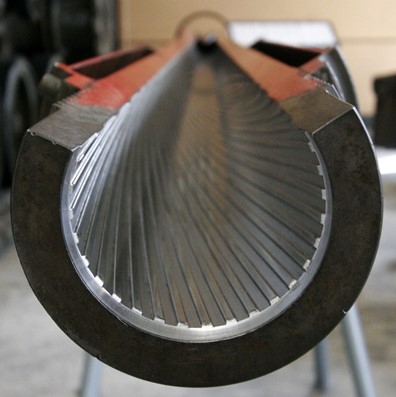
---Exhibit B---
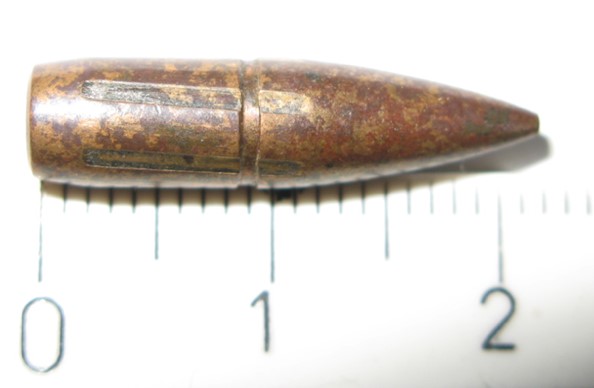


5
---Test-fired bullets admitted into evidence---
Q: Can you describe the process of obtaining these test-fired bullets?
A: The test-fired bullets came from a test fire of the gun recovered from the traffic stop.
Q: You mentioned test firings; can you explain what that means?
A: In test firing, first what I would do is make sure the firearm is safe to actually test fire. Then I would use lab ammunition and I would test fire it, meaning that I am creating a fired bullet. Typically you do two at a time. That way you have a fired bullet to compare to another fired bullet.
Q: Would you then have taken the test firings you created and did you compare those test firings to the fired evidence that you had also received?
A: Yes. First what I would do is compare my test shot to test shot. I am looking for a detailed microscopic pattern. Once I have done that then I would compare it to the fired evidence.
Q: And how about the number of lands and direction of twist for the test fires?
A: It also had six lands, and twisted to the right.
Q: Okay. Now, did you compare the test-fired bullets to the fired evidence under the comparison microscope?
A: Yes, I did.
Q: Can you describe the process of obtaining these test-fired bullets?
A: The test-fired bullets came from a test fire of the gun recovered from the traffic stop.
Q: You mentioned test firings; can you explain what that means?
A: In test firing, first what I would do is make sure the firearm is safe to actually test fire. Then I would use lab ammunition and I would test fire it, meaning that I am creating a fired bullet. Typically you do two at a time. That way you have a fired bullet to compare to another fired bullet.
Q: Would you then have taken the test firings you created and did you compare those test firings to the fired evidence that you had also received?
A: Yes. First what I would do is compare my test shot to test shot. I am looking for a detailed microscopic pattern. Once I have done that then I would compare it to the fired evidence.
Q: And how about the number of lands and direction of twist for the test fires?
A: It also had six lands, and twisted to the right.
Q: Okay. Now, did you compare the test-fired bullets to the fired evidence under the comparison microscope?
A: Yes, I did.
9
A: Exhibit C shows an image of a comparison microscope, as well an an example of a matching bullet comparison.
---Exhibit C---


10 Q: Did you use an algorithm to compare these bullets as well?
A: Yes, I used the algorithm to compare the two test fires to each other. I also used the algorithm to compare the better-marking test fire to the fired evidence that I received.
Q: Could you explain how this algorithm compares bullets?
A: The algorithm uses 3D measurements to make a comparison between the surface contours of each of the lands on each bullet. These comparisons result in a match score between 0 and 1, where 1 indicates a clear match, and 0 indicates that there is not a match. The bullet is aligned based on the maximum agreement between the lands, and the average match score for the lands is computed. This average score gives an overall match score for the entire bullet.
Q: What was the match score between the two test-fired bullets?
A: The match score was 0.976.
A: Yes, I used the algorithm to compare the two test fires to each other. I also used the algorithm to compare the better-marking test fire to the fired evidence that I received.
Q: Could you explain how this algorithm compares bullets?
A: The algorithm uses 3D measurements to make a comparison between the surface contours of each of the lands on each bullet. These comparisons result in a match score between 0 and 1, where 1 indicates a clear match, and 0 indicates that there is not a match. The bullet is aligned based on the maximum agreement between the lands, and the average match score for the lands is computed. This average score gives an overall match score for the entire bullet.
Q: What was the match score between the two test-fired bullets?
A: The match score was 0.976.
11
A: Exhibit D shows the comparison grid between the two test-fired bullets.
---Exhibit D---
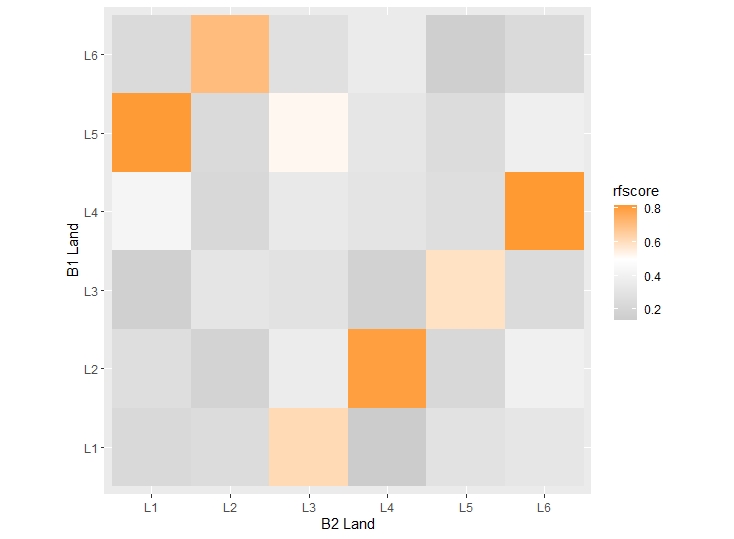

18 Q: Now, how many times have you compared bullets to determine if they were fired from the same gun?
A: I'd say thousands.
Q: And do you ever see two bullets that have agreement in every single area of the bullet?
A: No. When firing a firearm there is a dynamic process because it is a contained explosion. When the firing pin hits the primer, which is basically the initiator, what gets it going, it will explode, burn the gun powder inside the casing, and the bullet will travel down the barrel, picking up the microscopic imperfections of the barrel, and the cartridge case will slam rearward against the support mechanism. During that dynamic process, each time it happens, a bullet will be marked slightly differently from one to the next.
Q: When you reached a conclusion, did you write up a report?
A: Yes, I did.
Q: Is it the local police department's protocol to have somebody else who's a firearms tool mark examiner in your lab review that report, review your work, and determine if it's correct?
A: Yes.
Q:That's what we call peer review?
A: Peer review, yes.
Q: Thank you, no further questions.
A: I'd say thousands.
Q: And do you ever see two bullets that have agreement in every single area of the bullet?
A: No. When firing a firearm there is a dynamic process because it is a contained explosion. When the firing pin hits the primer, which is basically the initiator, what gets it going, it will explode, burn the gun powder inside the casing, and the bullet will travel down the barrel, picking up the microscopic imperfections of the barrel, and the cartridge case will slam rearward against the support mechanism. During that dynamic process, each time it happens, a bullet will be marked slightly differently from one to the next.
Q: When you reached a conclusion, did you write up a report?
A: Yes, I did.
Q: Is it the local police department's protocol to have somebody else who's a firearms tool mark examiner in your lab review that report, review your work, and determine if it's correct?
A: Yes.
Q:That's what we call peer review?
A: Peer review, yes.
Q: Thank you, no further questions.
22 Q: Is there something fixed about the amount of what has to be found to constitute sufficient agreement?
A: No, there is not a fixed amount or a numerical value.
A: No, there is not a fixed amount or a numerical value.
26 Q: How long did you say you've been trained in the bullet matching algorithm?
A: Since January of 2020.
Q: Okay. So that's fairly new, is that fair to say?
A: It is still fairly new, yes.
Q: The software uses modeling; is that correct?
A: Yes, it does.
Q: You, personally, don't know the source code; is that correct?
A: That's correct.
Q: And, in fact, you, personally, would not be able to tell us the specific math that goes into this program; is that fair to say?
A: We did receive training on what the math is doing in general terms, but I am not a statistician, and would prefer to let them speak to that.
A: Since January of 2020.
Q: Okay. So that's fairly new, is that fair to say?
A: It is still fairly new, yes.
Q: The software uses modeling; is that correct?
A: Yes, it does.
Q: You, personally, don't know the source code; is that correct?
A: That's correct.
Q: And, in fact, you, personally, would not be able to tell us the specific math that goes into this program; is that fair to say?
A: We did receive training on what the math is doing in general terms, but I am not a statistician, and would prefer to let them speak to that.

